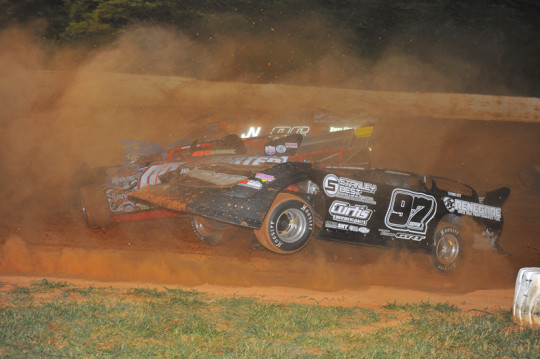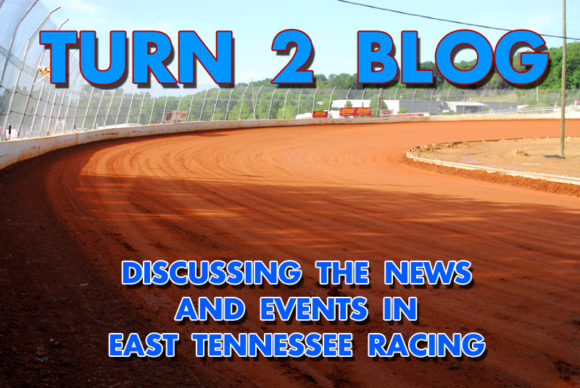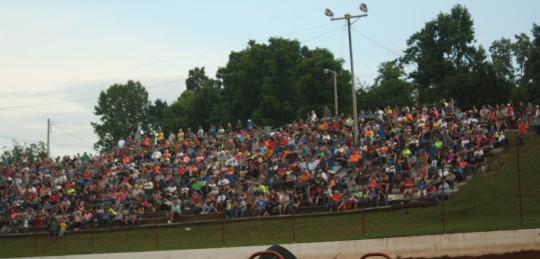*Turn 2 Blog is a regular feature on InsideDirtRacing.com. Here, site operators Michael Moats and Richard Allen take turns offering their thoughts on the dirt racing topics of the day from east Tennessee and beyond.
Richard: Recently, the two national touring series for Dirt Late Model racing along with numerous regional touring series through the Unified Late Model Council(Click here for a full list of the new regulations) announced that they would unite in terms of rules regarding safety and other aspects of the sport. Fuel cells and fueling systems, electrical systems, wheels, personal safety equipment(gloves, helmets, and head and neck restraints), seats, and fire suppression were all addressed in the bulletin.
Most of these now clearly stated requirements were already being employed by many drivers. And certainly, if they weren’t being used they should have been. As I see it, there are multiple positives to this announcement.
First, actually having these words on paper will make it known that these measures are to be taken seriously and will be enforced as such by the various sanctioning bodies. The tragic incidents resulting in deaths and serious injuries to have occurred in recent years clearly illustrated the fact that safety issues can never be taken lightly.
Second, the fact that the series did indeed agree to stand together could signify further unity in other areas that are more competition related. Over the past couple of seasons, there has been more evidence of unity regarding competition measures, particularly those initially begun by the Lucas Oil Late Model Dirt Series last year to regulate rear suspension components. Unified rules would ultimately make it easier for competitors to race in multiple series over the course of a season with less added costs, which would greatly benefit regional drivers who don’t follow a particular circuit. Ultimately, that would seem to be better for the sport going forward.
What are your thoughts?
Michael: I am glad all the series came together on the safety rules. While most series act as though they are the only series going today (for promotions sake), they know any driver can show up and race in any series at any time. Having the same rules makes it clear to the drivers there will be no variation regardless of which series they run.
I think some people would be surprised to learn just how much some of the regional drivers skimp on safety equipment.
I am hopeful coming together on safety rules will be the beginning when it comes to other rules. I would like to see some standards on the bodies on these cars. The flat nose pieces and “skateboard ramp” filler panels are one thing I would like to see addressed.
Back to the safety equipment, I wonder if all of this came about because of the number of head injuries and some of the serious fires we have seen by high profile drivers recently. I am glad is something is being done now. We don’t need to lose any more talented drivers from the sport.

New safety regulations should improve the chances that drivers will walk away from crashes such as this one.
Richard: The number of top name drivers to be impacted by serious injuries this year has been alarming although one would hope that it does not take a star driver getting hurt to bring about safety regulations, and I don’t think that is the case. Racing is, by its very nature, a dangerous sport so any measures that reduce the risks involved ought to be applauded.
While I have seen a couple of complaints registered by regional drivers on social media regarding the new measures, especially related to the cost of updating equipment, this is a definite step in the right direction for the sport. If a driver and/or team has to skimp on safety in order to be more competitive, he/they probably don’t need to be racing at that level anyway.
You make a good point regarding the bodies on these cars. As more and more is learned about aerodynamics, the more fine tuning that is bound to be done to maximize the air flow over and around the machines. Before you know it, this form of racing will(or already has) begin to resemble NASCAR and other “big time” forms of racing in which cars have become unable to pass one another due to aerodynamics.
Like you, I would hope the next thing to be addressed would be in the area of car bodies before this gets completely out of hand.
Michael: I am certainly not calling for spec bodies or anything like that. I would like to see some measures taken to see some of the aero taken out of the cars.
One thing in the safety rules I did not see addressed that I thought would be is the placement and securing of lead weights on the car. Lucas has theirs already in place. But after seeing the scary incident with Steve Francis getting hit earlier this year in the front of the helmet by a lead weight that came off a car, that was one of the first things I thought of when I saw the notice come down about safety standards. Maybe all series have the same rule as Lucas, maybe it’s one of those things that only gets checked from time-to-time. I don’t know the answer.
Richard: Agreed. The possibility of a lead weight striking a driver or being knocked into the stands and hitting a spectator is almost unthinkable.
To change the subject a bit, we are winding down the season here in this area with only a scant few events slated to take place over the next couple of weeks. But also consider that the “off season” is barely off at all with racing action starting back up in the east Tennessee region in January. With that said, having races being contested well into November then turning back around and firing up in January, promoters are taking a risk as weather could very well play a factor in determining attendance for these races.
Although this year’s weather has been well outside the norm, the temperatures in this area can still drop significantly in just one day. Along those lines, I recently asked racing fans just how much a prediction of cold temperatures affects their decision to attend racing events.
Of 296 people who responded to the poll question on Twitter, 64% said that weather forecasts do not prevent them from heading to a racetrack. However, that means 36% of those who chose to answer the question would stay away if they expected to be uncomfortable while sitting in the grandstands.
While if sounds great that 64% would brave whatever elements there may be to support their local track, the 36% who opt to stay home would cause a significant loss of revenue for the facility.
I guess the point is that with racing almost becoming a year long sport here, promoters must plan wisely in order to not lose money.
Michael: Losing a potential 36% of attendance and revenue seems like a risky proposition to me. The odd thing is many of these events seem to have really strong car counts. The promoters certainly stand a chance to make up some of that loss.
I am worried that with things going almost year-round there could be a burnout among fans and drivers. The holidays are coming up. Fans and drivers will be looking to spend time with family and friends. Drivers are looking for down time to get a new car ready, freshen engines, or other factors after a long season. I look at NASCAR and they basically get two months off from traveling. I think that’s not enough. I feel that’s why drivers like Jeff Gordon and Tony Stewart are opting to retire early – to get away from the grind. I’m hoping the same thing doesn’t happen to this sport.
Richard: It seems as if sports entities like the NASCAR and even the almighty NFL are dealing with the problem of oversaturation which is showing itself in lowered television ratings. Dirt racing could be running the risk of suffering the same fate in terms of having so many events that fans become more selective as to what they attend. That said, however, many of these late season races do seem to draw good crowds when the weather is agreeable. And as you point out, car counts are typically quite good as the number of races to choose from for the competitors dwindles.
The possibility of oversaturation is a danger for dirt racing since fans have to actually pay to watch their sport, whether it be in person or on a pay-per-view basis, rather than tune in on free TV.
So it isn’t just weather that promoters have to worry about with these early and late season races.
Michael: I think some of these late season events will run into trouble as some have expanded into two and even three-day programs. We have seen some of these events have terrible attendance on the first night. It may come down to fans not accepting more racing, but rejecting the format and the ticket prices for some of these events, especially combined with the weather forecast. Only time will tell.







